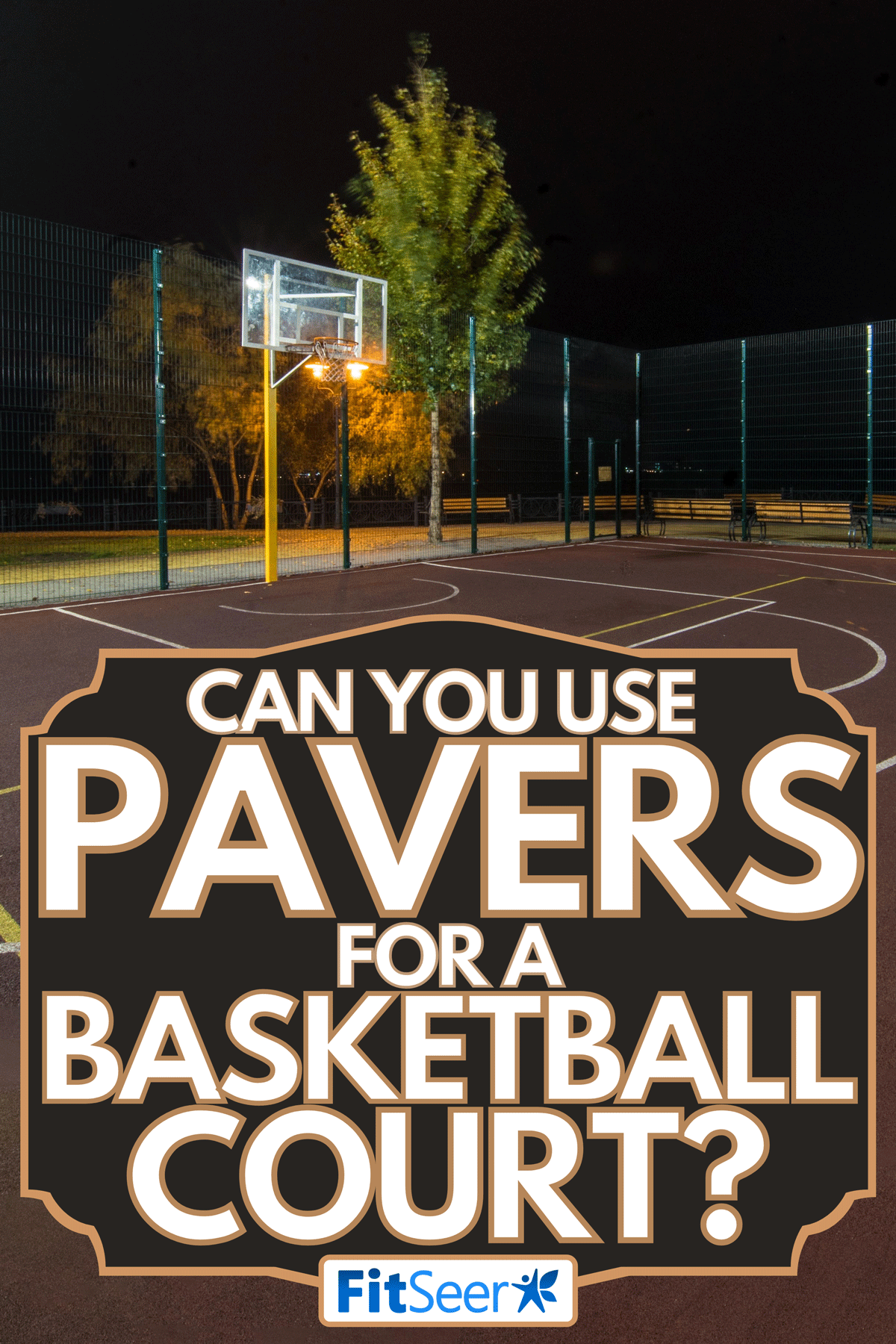If you want to build a basketball court, you are probably wondering the different ways to do so. For example, can you use pavers to build the court? Let's take a look and see if this is a viable option for your basketball court!
Using pavers is a great way to create a base for your basketball court. Not only do pavers help withstand erosion, but they also give a flat foundation for the court. In addition, using pavers is stronger and more environmentally safe than using a traditional concrete slab.
Putting in an at-home basketball court isn't a small project. That's why in this article, we will discuss using a paver for laying a court foundation. In addition, we will answer other frequently asked questions about installing a basketball court, so read on!

Can You Use Pavers For A Basketball Court?
A paver is a type of construction material commonly used for paving roads, driveways, and sidewalks. Pavers come in various shapes and sizes and can be made from a variety of materials, including concrete and natural stone.
Building a basketball court with pavers is entirely possible. By using this method, you will have a sturdy foundation that is guaranteed to stand the test of time.
In addition, using pavers for your at-home court has three main benefits: they are smooth and flat, ensure a level playing surface, prevent erosion from happening, and are more environmentally friendly.
Using pavers vs. a concrete slab allows for moisture to seep through. This allows for natural drainage, which helps recharge the groundwater supply.
The difference between using a paver and laying a concrete slab is the amount of weight they can endure. For example, a typical concrete slab can only withstand 2,500 PSI before cracking. In comparison, using pavers can withstand as much as 8,000 PSI.
While you won't be dribbling a basketball with that kind of force, you can rest assured that the pavers won't break down as quickly. However, one thing to know is that using pavers is typically more expensive than a concrete slab. Concrete can cost $6-$10 a square foot, and paving could be $10-$20.
Which one you choose is up to you, but it's good to know you have options.

How do you make a paver basketball court?
For making a paver basketball court, follow these steps:
- The first thing you will want to do is clear out your area of any rocks, twigs, or other materials that can damage your paver. You'll then place a weed barrier down around the perimeter of this area. This keeps weeds from growing up between your pavers.
- Once you have cleared and leveled the area, you will want to lay a 1" thick layer of concrete sand. This will help with the final interlocking process. Be sure to account for one cubic yard of sand per 300 feet of the project area.
- Next, you will want to create a suitable edge restraint for your court area. This will help avoid the movement of the sand bedding and pavers. You can use a hard edge such as the house to start the edge restraint.
- Once this is done, you can start laying your pavers. First, lay the pavers flat in a forward motion. It helps if you work in a 90-degree corner and use a preset line to help keep the pavers straight.
- Once your foundation is complete, you can move on to vibrating the pavers. First, spread a light layer of sand over the pavers and vibrate the sand using a vibrating plate compactor. By doing this, you will make interlocking the pavers easier.
- Next, lay a 1/4" inch deep masonry or dry paver joint over the paver surface. Again, use the vibrating plate compactor over the pavers to fill the gaps. Repeat this process two or three times to ensure the interlocking of the pavers.
- Lastly, sweep any leftover sand into the pavers until they are filled. Let the pavers sit for 48 hours so they have time to finish the interlocking process. Afterward, you can add your three-point line, free line, and baseline if you choose to do so!
What type of concrete is used for basketball courts?
Typically, basketball courts are made with a 4" thick concrete slab. The slab should be able to withstand 3,500 PSI and have 1/2 inch rebar slabs. Therefore, concrete slabs are deemed the optimal choice for a basketball court. This is because concrete is weather-resistant and long-lasting.
The concrete slab creates a smooth surface for a basketball game when done right. However, if the concrete slab is installed incorrectly, you may have cracking and bleeding issues.
This means that moisture seeps into the bottom of the concrete. Over time, the moisture will expand and contract, causing the top surface of the court to warp and crack.
If you will install a concrete slab basketball court, then hire a professional. If you don't, you can risk having the concrete ruined and costing you twice as much to have it fixed.
How much does it cost to make an outdoor basketball court?
Several factors go into the total cost of an outdoor basketball court. On average, a basketball court will cost anywhere from $4-$16 per square foot.
So, the first thing you need to decide is how big you want to make the court. A full-size basketball court is 94 feet long and 50 feet wide. While most people don't have the room to add a full basketball court, it is an option.
It also depends on what material you want to use for the court itself. One of the most popular choices in basketball court surfaces is concrete. There are different types of concrete you can use in your court.
As mentioned earlier, you can choose to use pavers for your court. Whichever you choose is up to you, but you will want to ensure it's done right the first time.
To save you money, you can build half a basketball court. Half a basketball court will cut costs and give enough room to practice and play pickup games. With that being said, you can pay anywhere from $17,000 to $70,000 or more to have an outdoor basketball court.
Do I need an outdoor basketball court to practice?

While you can practice on a driveway or sidewalk outside your house, an outdoor basketball court is more ideal. You can work on your shooting, dribbling, and passing skills without a basketball court.
However, if you want to work on your gameplay, having a full court will help. If you don't have a court at your home or a local park, then check out a YMCA or school gyms for time to practice.
The next best thing is to get a portable basketball hoop and set it up in your driveway. Having a portable hoop installed will give you the feel of playing on an outdoor court. To help, set your portable hoop to league height (10 feet), so it can transfer to league play.
What is the best basketball court paint?
The best paint for an indoor and outdoor basketball court is acrylic. There are several reasons why acrylic paint is the best. One, it is slip-resistant, which makes sit safer for play.
Two, it will protect your court from moisture damage. Finally, acrylic paint will give a smooth finish that is easy to clean and prevent cracking when installed correctly.
Three, acrylic paint can withstand exposure to chemicals. Four, acrylic paint will provide a firm grip on the surface.
Lastly, there is an assortment of choices for color options for basketball court colors. So whether you want a color that will stand out for basketball or a color that fits in with your home's exterior, there is an option for you.

How do you maintain an outdoor basketball court?
One of the most important things to sweep your court free of debris and foreign objects. This will allow the paint to last longer and should be done at least once a week.
In addition, you should do maintenance on the basketball hoop itself. Don't hang on the rim and replace the net when it endures wear and tear. It is good to remove the rim and the net during the cold season to avoid cold temperatures.
Final Thoughts
An outdoor basketball court can be a fun way to spend time with friends and family. Whether you want a full-court or half-court, there are options from which to choose. If you decide to do the project yourself, take the time to do it right the first time.
For more articles on basketball, check out our website:
How High Should The Ceiling Be For An Indoor Basketball Court?






![Read more about the article Does Tennis Give You Abs? [The Answer Might Surprise You!]](https://fitseer.com/wp-content/uploads/2021/10/Sexy-male-tennis-player-in-black-background-500x333.jpg)
